Tell students to Enjoy their Thanksgiving Dinosaur!
Turkeys have surprising relatives: meat-eating theropod dinosaurs like Tyrannosaurus. In fact, T-Rex, the king of the dinosaurs, and turkeys shared a common ancestor about 190 million years ago. Today’s birds are living dinosaurs, and chickens, as well as turkeys, have kept more dino DNA than other birds alive today. That makes the TG gobbler a closer relation to T-Rex than fearsome birds of prey like eagles and falcons.

The feathered Archaeopteryx, also a theropod, is believed to be the transition from dinosaurs to birds. Unlike other larger theropods, Archaeopteryx was only the size of a crow. Among the characteristics that Archaeopteryx and other dinos share with birds are the shapes of their wrists and ankles, as well skull shape. Another anatomical trait that many birds and dinosaurs share is the presence of a furcula. Wishbone
The furcula (Latin for "little fork") is a “Y”, “U”, or “V” shaped bone. It is formed by the fusion of the two clavicles (collar bones). More commonly called a wishbone, it can be left a day or two to dry and then used by two people in an old tradition. One person grabs each side and pulls. The person getting the bigger part gets a holiday wish. 
Using wishbones and birds for superstition dates to ancient times with the domestication of poultry. People in medieval Europe, as well as Ancient Greeks and Romans valued wishbones and chickens, considering them sacred. Rituals using chickens have been performed in both Judaism and Santeria. European and Scandinavian customs include using a dried goose’s breastbone to predict the coming winter. 
Now just a Thanksgiving tradition, making wishes with wishbones was once more common because people regularly cooked whole birds. These days, to save time, people usually eat processed poultry like chicken breasts, wings, or ground turkey. Remind your students that they can also find a furcula the next time they grab a rotisserie chicken from the store. That Y-shaped wishbone can remind them that birds have skeletons, just like dinosaurs and us! The Function of the Furcula
In birds, the primary function of the furcula is to strengthen their thoracic skeleton to withstand the rigors of flight. In theropods it was an anchor point for muscles of the forearms and could have been instrumental for a wide variety of forearm movements. 
A secondary function of the furcula may be to assist breathing. Birds, unlike mammals, have unidirectional respiratory systems. Unidirectional respiratory systems use air sacs to store and pump air through lungs, thereby providing a constant supply of fresh oxygen. The air sacs are connected to bones, such as the furcula, which also have hollows and can store oxygen. 
Hollow, or pneumatic, bones are also found among facial bones of animals (including humans). Scientists believe that birds having air sacs attached to their bones provides greater strength for the bird’s skeleton, helps cool them by diffusing heat, and keeps them light. This efficient unidirectional respiratory system allows birds to breathe where oxygen concentration is lower, like at much higher altitudes than where mammals could survive.
Pneumatic Bones
Study of rib and vertebrae fossils indicates that dinosaurs may have had bird-like lungs. Of course, to date, no fossilized dinosaur lung tissue has been found. But, if dinos did have efficient bird-like lungs, it would explain their ability to thrive in the Mesozoic era (252 to 66 million years ago). When dinosaurs ruled the world, the air had less oxygen than it does today. Bird-like lungs may’ve given dinosaurs an advantage over other animals by allowing them to take in the oxygen they needed to sustain a fast metabolism and lots of physical activity.

The large herbivorous long-necked sauropods also had a system of air sacs in their vertebrae. Hollow bones in their necks would have been much more manageable and would have allowed oxygen to flow more freely in their bodies. It's estimated that pneumatic bones made their necks so light that their vertebrae were 60% air. Birds Are Living Dinosaurs, But Your Thanksgiving Turkey is a Dead Dino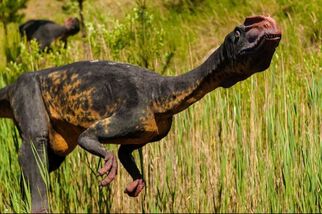
Scientists are always learning more about dinosaurs. Feathers and systems of air sacs inside the body were widespread, and the wishbone is just one small example of this evolutionary connection. But, fused clavicles, the furcula or wishbone, was only present among the theropod dinosaurs. 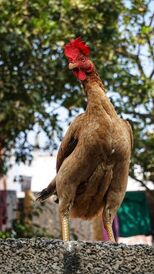
In addition to the furcula, other traits that birds and dinos like theropods share include bipedal stance, air-filled bones, hinge ankle joints, 3-fingered hands, swiveled wrist-bones, and feathers. Even T-Rex had feathers, but for temperature regulation, not flight. 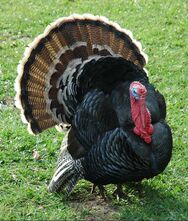
Turkeys today have flight feathers, but your typical pen-raised Thanksgiving turkey truly is a "Butterball". It's far too plump and breast-heavy to fly. Wild turkeys, however, soar up to roost in trees at night. Comparing a Human and Avian Skeleton
The arm bones of the human consist of the humerous, the radius, and the ulna. These bones are also found in the bird. The hands of birds differ substantially from humans. Some bones have been reduced and some others have merged with each other. Together they are called the carpometacarpus.

The leg consists of a long femur which attaches to the pelvis and then two bones of the lower leg. In the bird, these two bones, the tibia and fibula, are fused together. In humans, they are separated. The tibia of the bird is the part we call the drumstick. The bone inside the bird's thigh is its the femur.

The head of both birds and humans is protected by a large cranium. The upper jaw of the human, and the upper beak of the bird is composed of a bone called the maxilla. The lower jaw and lower beak is composed of a bone called the mandible. 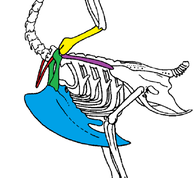
The differences between the bird and human skeleton are very apparent in the pectoral girdle, which is the place where the forelimbs attach to the spine. The bird's forelimbs are wings and must have a strong support system. The clavicle of the bird is fused to form the furcula, or wishbone. In addition to the scapula, that humans have, birds also have a shoulder bone called the coracoid.

Another obvious difference between the human and bird skeleton is the shape and size of the sternum. A bird's sternum is large and positioned under the body - flight muscles attach to this bone. The ridge of the bird's sternum is called a keel. The ribs are attached to the spine and to the sternum. 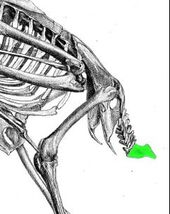
The vertebrae of the bird and human are similar except for the bone where the tail feathers attach, called the pygostyle. A Bendy bird bone activity!Watch the tikTok video below, and try this out in your own classroom!
Celebrate the holiday in your classroom while you teach students science concepts related to the iconic Thanksgiving Turkey!
0 Comments
|
AuthorGertrude Katz has spent over 30 years teaching K-12 public school students all major subjects. She has taught biology and education at the college level. The majority of her career has been spent instructing biology at the secondary level. Categories
All
|


 RSS Feed
RSS Feed